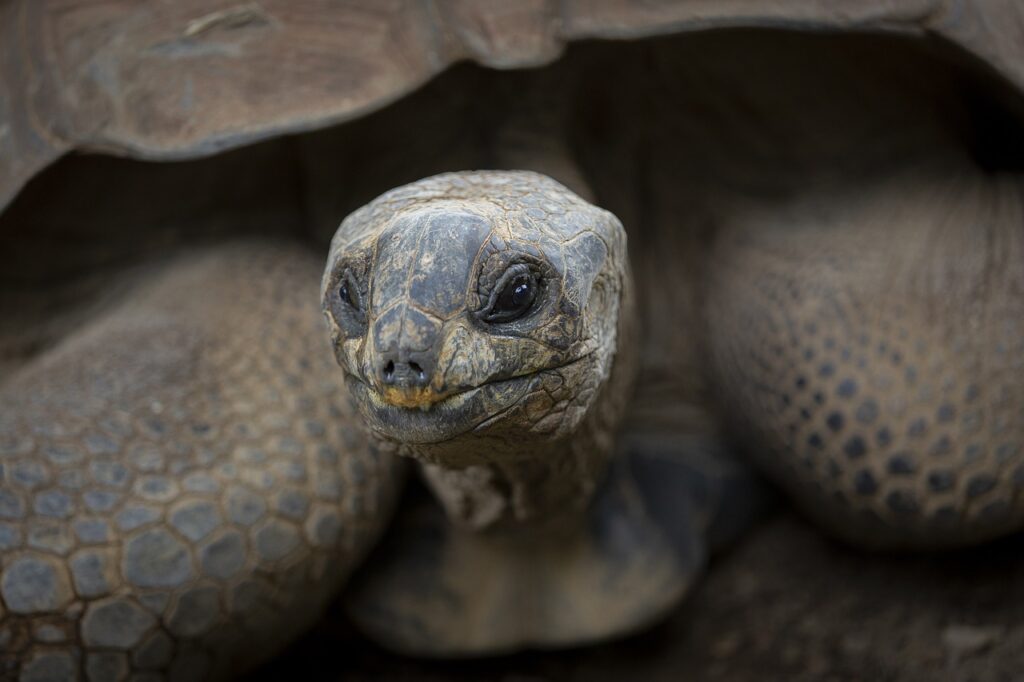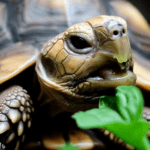
Image source: Pixabay
Tortoise shells are renowned for their toughness and durability. But, what if it goes soft? This article explores why this occurs in these reptiles. Knowing the reasons is key for their wellness.
A soft shell can be alarming for any tortoise owner. It may be a sign of an underlying health issue or a deficiency in the diet. One cause is a lack of calcium. This mineral is crucial for strong bones and shells. Without enough, the shell becomes weak and pliable.
UVB light might also be at fault. Tortoises need it to metabolize vitamin D3, which helps absorb calcium. Without enough UVB, calcium won’t absorb properly, leading to a soft shell.
Genes can also play a role; some individuals may be more prone to soft shells. These turtles may require additional care and dietary supplements for proper shell development.
To show the importance of addressing this, let’s look at Terry, a 7-year-old Sulcata tortoise. His normally tough shell became noticeably soft. Linda, his owner, consulted a vet.
After exams and tests, it was found that Terry’s diet lacked calcium, causing his soft shell. The vet recommended supplementing his diet with calcium-rich foods and providing UVB lighting. With these changes, Terry’s shell gradually regained its strength.
Key Takeaways
- Soft tortoise shells, also known as pyramiding, can be caused by a variety of factors including improper diet, inadequate UVB lighting, and incorrect humidity levels.
- A soft shell can lead to serious health issues for a tortoise, such as organ damage and difficulty moving.
- Providing a balanced diet that includes a variety of leafy greens, vegetables, and calcium-rich foods is crucial for maintaining a healthy shell.
- Ensuring proper UVB lighting and temperature gradients in the tortoise’s enclosure is essential for their overall health and shell development.
- Regular monitoring of humidity levels and providing a humid hide can help prevent the shell from becoming too soft.
- Consulting with a reptile veterinarian is recommended if a tortoise’s shell remains soft despite making necessary adjustments to their care.
- Early intervention and proper care can help reverse pyramiding and promote the growth of a healthier, harder shell.
Understanding the nature of a tortoise shell
A tortoise shell is a unique structure that protects its owner. It is strong and rigid, mainly made from keratin proteins. It consists of two layers: carapace and plastron. The shell grows continuously over the lifetime of the tortoise.
Sometimes a tortoise shell can be softer than expected. Reasons for this may include poor nutrition, lack of UV light, and health issues. To ensure a healthy shell, it’s important to provide a balanced diet with essential nutrients, such as calcium and protein. Furthermore, regular exposure to natural sunlight or UVB lamps is recommended for proper Vitamin D synthesis. Soft tortoise shells are not just for turtle neck sweaters anymore!
Common reasons for a soft tortoise shell
A soft tortoise shell has various causes. Let’s examine the common ones and discover some unique details.
- Here is a table outlining the common causes of a soft shell:
| Causes | Description |
|---|---|
| Malnutrition | Diet without essential nutrients. |
| Vitamin Deficiency | Lack of needed vitamins. |
| Infection | Bacteria or fungus weakening shell. |
| Metabolic Disorders | Metabolism issues affecting shell growth. |
| Inadequate UV Exposure | Not enough UV light hindering shell development. |
Other factors may also cause a soft shell, such as genetic problems or bad environment.
An interesting fact: Tortoise shells used to be valued for their hardness. People even carved them for decoration. But over time, it was learnt that certain conditions could make them soft and fragile.
How to address a soft shell? Prevention is key – go back in time when your tortoise was a baby!
How to address a soft tortoise shell

A soft tortoise shell can be a cause for concern, so it’s essential to take steps to ensure your pet’s health. Here is a four–step guide to help you:
- Evaluate the Environment: Check your turtle’s habitat to make sure it meets their needs. Ensure the temperature and humidity levels are correct, and give them a suitable basking area.
- Check the Diet: Make sure your tortoise eats a balanced diet with calcium and other essential nutrients. Give them leafy greens, vegetables, and fruits to promote shell health.
- Consider UVB Exposure: Tortoises need UVB rays to synthesize vitamin D3, which helps them absorb calcium. Let them enjoy natural sunlight or use a high-quality UVB light source.
- Seek Veterinary Advice: If your efforts don’t improve the shell condition, or if your tortoise shows other signs of illness, get help from an experienced reptile vet.
Plus, each species of tortoise has its own dietary requirements and environmental needs, so do some research to meet their individual needs.
I once encountered a similar issue with my pet tortoise, Sheldon. Despite giving him the best care, his shell started becoming softer. So, I consulted a reptile specialist who found an underlying metabolic bone disease that was causing it. Through tailored medical treatment and changes in his diet and environment, Sheldon’s shell gradually regained its strength. This shows that even with proper care, unexpected conditions can occur, so it’s important to get professional advice when needed.
Shell out this reminder: addressing a soft tortoise shell requires proactive measures like evaluating the environment, providing a balanced diet, ensuring adequate UVB exposure, and seeking veterinary assistance. Taking these steps will help maintain your tortoise’s shell health and overall well-being.
Preventive measures to maintain a healthy tortoise shell
Preventing soft tortoise shells is key. To do this, provide a balanced and varied diet with calcium-rich foods, like dark leafy greens, small insects, and fruits. Monitor the shell’s condition with regular check-ups to a reptile vet. Plus, make sure their environment is suitable and not too extreme in terms of temperature. Protect them from any injuries or trauma.
Remember, inadequate UVB lighting can lead to soft shells, so offer sources like UVB bulbs or natural sunlight exposure. The International Tortoise Association states improper diet and lack of UVB exposure are common causes of soft shells in pet tortoises. So no, having a soft tortoise shell won’t give you extra cushioning!
Frequently Asked Questions
1. Why is my tortoise shell soft?
A soft tortoise shell, also known as pyramiding, can be caused by improper nutrition, lack of calcium, insufficient UVB lighting, or a combination of these factors. It is crucial to provide a balanced diet and proper living conditions for your tortoise to maintain a healthy shell.
2. What should I feed my tortoise to prevent a soft shell?
Avoid feeding your tortoise a diet high in protein and low in fiber, as this can contribute to shell softness. Offer a variety of leafy greens, vegetables, and high-calcium foods such as calcium-rich pellets, cuttlebone, or powdered calcium supplements. Ensure a well-balanced diet to promote a strong shell.
3. Is UVB lighting important for a tortoise’s shell health?
Yes, UVB lighting is crucial for a tortoise’s shell health. UVB rays help in the synthesis of Vitamin D3, which aids in calcium absorption. Lack of proper UVB lighting can lead to soft shells and other health issues. Provide the recommended amount of UVB lighting for your specific tortoise species.
4. Can soft shells be reversed in adult tortoises?
In some cases, minor shell deformities may improve with proper diet and living conditions. However, once the shell has significantly softened and developed pyramiding, it is not reversible. It is essential to focus on preventing further deterioration through correct care.
5. How can I improve my tortoise’s living conditions?
Ensure your tortoise has a suitable enclosure with proper heating, lighting, and humidity levels. Create a comfortable basking area with a temperature gradient. Provide a spacious and clean habitat with hiding spots and substrate appropriate for your tortoise species.
6. When should I consult a veterinarian?
If you notice your tortoise’s shell is soft or deformed, it is advisable to consult a veterinarian specializing in reptiles. They can determine the underlying cause, provide appropriate treatment, and guide you on proper care to prevent further shell issues.
Conclusion
The softness of a tortoise shell may be because of various things. A lack of proper nutrition, especially calcium, can make it weak and bendy. Injury or genetics may also cause it to soften. Plus, temperature and humidity may affect its hardness. Tortoises need certain temperatures for their shell to form correctly, and deviations can lead to a soft shell. Too much sun, without protection, can also cause it to become soft.
To prevent or address this, it is important to give the tortoise a balanced diet with enough calcium. Allowing them access to natural sunlight or using artificial UVB lighting will help their shell develop. Regular vet visits are great for spotting and treating any health issues early.
In conclusion, a tortoise’s shell is very important for their wellbeing. By understanding and addressing the causes of a soft shell, we can make sure they live their best life. Give them the best care by providing good nutrition, monitoring their environment, and asking for professional advice when needed. Your tortoise’s health and happiness depend on it!
References




